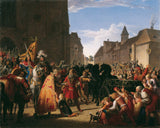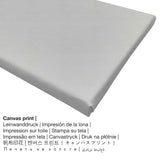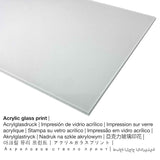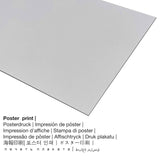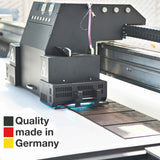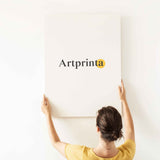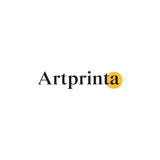Anton Petter, 1826 - Wenzel jụrụ Rudolf von Habsburg ka ọ bụrụ ahụ nna ya Przemysl Ottokar - mbipụta nka mara mma.
Ụtụ gụnyere. Mbupu gbakọrọ na ndenye ọpụpụ.
Additional information by Belvedere website (© Copyright - Belvedere - Belvedere)
Immediately after the battle of Dürnkrut (1278), the Roman King Rudolf von Habsburg moved in with his entourage in Vienna. After he had thanked God in St. Stephen for the victory over the Czech King Przemysl Ottokar, he wanted to receive the homage of the people of Vienna. As he hurried Wenzel against the son of the enemy and later King Wenceslas II. Of Bohemia. He asked for his father's body, which can be seen on the hearse right. Not strange Vienna this was to be buried, but in his hometown of Prague. The presentation is the heroic poem "Rudolf von Habsburg" (published in 1825) were taken that had the then Patriarch of Venice, Ladislaus Pyrker written. Petter, who was then a professor of history painting at the Vienna Academy was created one of his most expressive work with this image. The genre-like view of historical events is otherwise used in any of his works. Noteworthy is the exact reproduction of the facade of the giant gate of St. Stephen's Cathedral. The cloak Rudolf shoulders is the coronation robe that was 1133/1134 made for the Norman King Roger II.. This was part of the vestments of the coronation of kings and emperors of the Holy Roman Empire was used (most recently in 1792 at the coronation of Francis II. [I]). Today it is in the treasury in the Hofburg. [Sabine Grabner 8/2009]
Iberibe ozi ndabere nka
| Aha nka: | "Wenzel asks Rudolf von Habsburg to his father's body Przemysl Ottokar" |
| Nhazi nka: | sere |
| Nhazi nka: | nkà nke oge a |
| Nhazi oge: | 19th narị afọ |
| Afọ nka: | 1826 |
| Afọ nka: | karịa afọ 190 |
| Ihe osise izizi: | mmanụ na kwaaji |
| Ogo nke ọrụ nka izizi: | 180 x 222 cm - etiti: 200 x 241 x 10 cm |
| mbinye aka izizi nka: | signed and dated lower left: Anton Petter / 1826 |
| Egosiputara na: | Belvedere |
| Ebe ngosi nka: | Vienna, Austria |
| E Nwere na: | www.belvedere.at |
| License: | ngalaba ọha |
| Site n'aka: | © Belvedere, Vienna, nọmba ngwa ahịa: 3723 |
| Ebe E Si Nweta: | nyefee site na Kunsthistorisches Museum, Vienna. - 1939 ngwaahịa na 1921 |
Nyocha ngwa ngwa nke onye na-ese ihe
| Ihe nkiri: | Anton Peter |
| Aha utu aha: | Anton Petter, petter anton, Petter Anton |
| okike onye nka: | nwoke |
| Obodo onye nka: | Ọstrịa |
| Ọrụ onye na-ese ihe: | onye na-ese ihe, onye nkuzi mahadum |
| Mba onye si: | Austria |
| Nhazi nke onye nka: | omenkà nke oge a |
| Ụdị nke onye na-ese ihe: | Ihunanya |
| Afọ ọnwụ: | 77 afọ |
| A mụrụ: | 1781 |
| Ebe omuma: | Vienna, Vienna steeti, Austria |
| Nwuru: | 1858 |
| Nwuru na (ebe): | Vienna, Vienna steeti, Austria |
Banyere ngwaahịa
| Ụdị edemede: | nka nka |
| Usoro mmeputakwa: | mmeputakwa n'ụdị dijitalụ |
| Usoro nhazi: | Mbipụta UV ozugbo (mbipụta dijitalụ) |
| Ihe ngosi: | emere na Germany |
| Stockdị ngwaahịa: | na mmepụta ihe |
| Eji ngwaahịa emebere: | mgbidi gallery, art mmeputakwa gallery |
| Nhazi nka nka: | usoro odida obodo |
| Oke akụkụ: | ( Ogologo: obosara) 1.2: 1 |
| Nsonaazụ: | ogologo bụ 20% ogologo karịa obosara |
| Akwa mmeputakwa dị: | ígwè ebipụta (aluminium dibond), acrylic glass print (nwere ezigbo mkpuchi iko), mbipụta akwụkwọ mmado (akwụkwọ kwaaji), akwụkwọ akwa akwa. |
| Nhọrọ nha nke akwa akwa n'elu etiti ihe na-agbatị (mbipụta kwaaji): | 60x50cm - 24x20", 120x100cm - 47x39", 180x150cm - 71x59" |
| Mpempe iko acrylic (nwere ezigbo mkpuchi iko) nha dị iche iche: | 60x50cm - 24x20", 120x100cm - 47x39" |
| Mpempe akwụkwọ mmado (akwụkwọ kwaaji) nha: | 60x50cm - 24x20", 120x100cm - 47x39" |
| Aluminom dibond ọdịdị nha ebipụta: | 60x50cm - 24x20", 120x100cm - 47x39" |
| Nhazi mbipụta nka: | ngwaahịa anaghị emebi emebi |
Họrọ ihe gị
Ndepụta ndetu ngwaahịa na-enye gị ohere ịhọrọ nha na akụrụngwa ọkacha mmasị gị. Anyị na-ahapụ gị ka ịhọrọ nha na akụrụngwa ọkacha mmasị gị n'etiti nhọrọ nhazi ngwaahịa ndị a:
- Kwaaji: A canvas direct print is a printed canvas mounted on a wooden stretcher. The great advantage of canvas prints is that they are relatively low in weight. This means, it is easy to hang up the Canvas print without extra wall-mounts. Hence, canvas prints are suited for all types of walls.
- Mbipụta iko acrylic (nke nwere ezigbo mkpuchi iko): A glossy print on acrylic glass, often labelled as a print on plexiglass, transforms your favorite original artwork into wonderful wall décor. Your favorite artwork is made with the help of modern UV direct printing technology. The acrylic glass protects your chosen art print against sunlight and external influences for decades.
- Akwụkwọ mmado ebipụtara (akwa akwa akwa): Our poster print is a printed sheet of canvas paper with a slightly roughened surface finish, which resembles the original artwork. The print poster is optimally suited for framing the art print in a custom-made frame. Please bear in mind, that depending on the absolute size of the canvas poster print we add a white margin 2-6cm around the work of art in order to facilitate the framing.
- Aluminom dibond mbipụta (ọla): Aluminium Dibond prints are metal prints with an impressive depth effect. The Aluminium Dibond Print is the ideal start to the sophisticated world of fine art prints manufactured on aluminum. The colors are luminous and bright in the highest definition, fine details of the print are crisp.
Ama
a 19th narị afọ nka nka aha Wenzel asks Rudolf von Habsburg to his father's body Przemysl Ottokar nke nwoke mere Ọstrịa artist Anton Petter in 1826. The masterpiece measures the size 180 x 222 cm - frame: 200 x 241 x 10 cm and was crafted with the medium oil on canvas. The original artpiece has the following text as inscrption: signed and dated lower left: Anton Petter / 1826. Besides, the work of art is in the the Belvedere's digital art collection, which is one of Europe's most famous museums with three locations that blends the experience of architecture and art in a unique way. We are glad to state that this ngalaba ọha masterpiece na-ọnọ n'ikike nke © Belvedere, Vienna, nọmba ngwa ahịa: 3723. : nyefee site na Kunsthistorisches Museum, Vienna. - 1939 ngwaahịa na 1921. Furthermore, alignment of the digital reproduction is in landscape format with a side ratio of 1.2: 1, nke pụtara na ogologo bụ 20% ogologo karịa obosara. Anton Petter was a painter, university teacher, whose art style can mainly be classified as Romanticism. The European artist lived for a total of 77 afọ, born in 1781 in Vienna, Vienna state, Austria and passed away in 1858.
Disclaimer: We try what we can to describe the art products with as many details as possible and to illustrate them visually on the various product detail pages. However, some colors of the printed materials and the imprint can differ marginally from the image on the device's screen. Depending on your settings of your screen and the quality of the surface, not all color pigments can be printed as exactly as the digital version on this website. Since all our art reproductions are printed and processed manually, there might as well be minor discrepancies in the motif's size and exact position.
© Nwebiisinka nke - Artprinta.com

